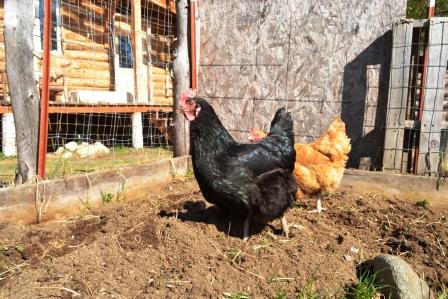
Home > Dispatches > Daily Dispatches 2014 > Daily Dispatch #162
June 13, 2014: Gardening: Relocating Worms
I noticed that when Pete was moving the far compost/manure pile into the potato bed area, that it was loaded with earthworms. This gave this non-gardener an idea, which was to dig up additional worms and put them in the various garden sites. I was really quite gung ho about doing this – as far as garden tasks go, this was right up there with turning compost. Like most things around here, this at first seemed like it would be an easy project, and a good one. I know enough about gardening to put under one’s dirt blackened thumb. What I know about worms is that they are good for gardens. |
|
| They move soil and they poop in it. The poop is called castings, and it is coveted by plant and vegetable growers. So I grabbed one of our many five gallon buckets, and as well, a long-handed shovel, and set to work. I decided to forego writing because the sky was gray/yellow, verifying what the radio weather guy said, which was that it was going to rain today, tonight, tomorrow, tomorrow night, ad infinitum. So, I went with the weather prediction, and began my task early in the day. I dug around in the pit area and soon found worms, lots of worms. There were fat worms and skinny worms and long worms and short worms and everything in between. I didn’t get any help. This was strictly a solo venture. Pete had to take a neighbor with a toothache to the Chickaloon Health Center, so I went at this project alone. No matter, like turning compost, collecting and redistributing the worms was a somewhat meditational activity. Well, I was not really alone. I went and got Freebird and Red Hen, and let them do what chickens do as I worked. Red Hen is the most amazing chicken we’ve ever had around this place – and we’ve had a few. She literally follows me around, from area to area. Freebird follows suit because this is what she thinks she needs to do. I started by putting the worms in the upper garden area – they were in the compost – pulling them out had turned out to be an impossibility. So I took clumps of compost and spread it on the various beds. The worms immediately began burrowing into the soft soil. I went back and loaded up again, and again, and again. All total, I put four bucketfuls of worms in the upper garden. I next put worms in the greenhouse beds. Pete recently built concrete beds; these replaced the previous bench-like arrangement. I was dubious about this, but I must say that his project was a success in terms of area ambiance. It just feels good to hang out in the refurbished greenhouse – and I’d like to think the tomatoes and basil also feel this way. I continued on with my project, also putting worms in the lower garden, the basil plants, and the hoop house. I have to say that there were times in which I’d dig for a while and not find any worms at all. The worms, I noticed, seemed to have a preference for certain areas. They avoided the hot spots where the manure and old hay were cooking, preferring to burrow down into the more decomposed stuff. The worms also liked the colder areas, which surprised me. And there were no worms in the soil on the sides of the pit. These worms were also very fast. I tried a few times to grab at clumps of them with my bare hands, but they would move fast, back into the compost. I of course hope that the worms will flourish in our garden. I suppose that some will die of shock; after all, this was a big, unprecedented move for them. But how cool it will be, in the near future, to dig my hands into garden soil, pull forth a handful, and discover that its inhabited by earthworms. Oh, the joy of being a – dare I say it? A gardener. |
|
